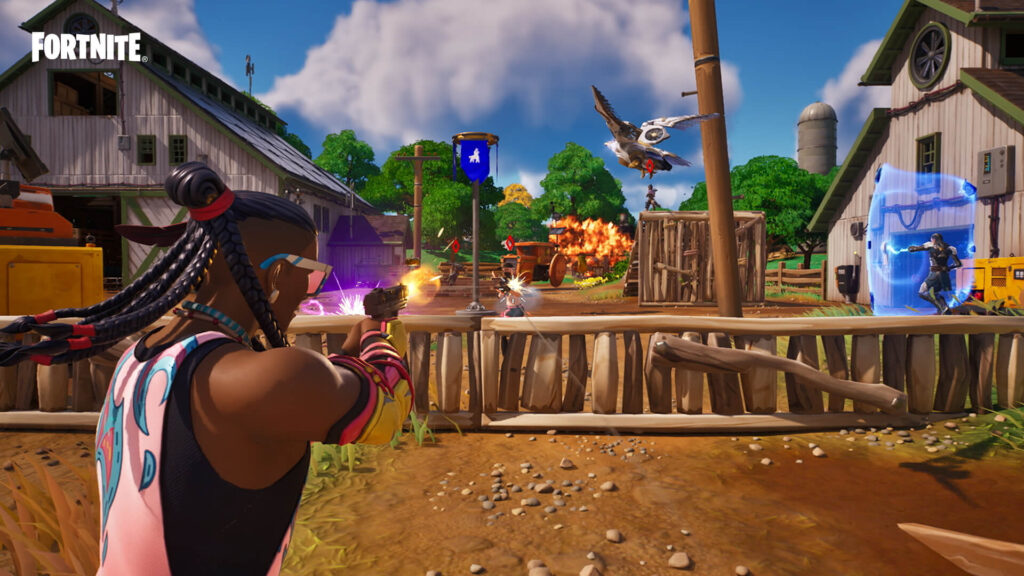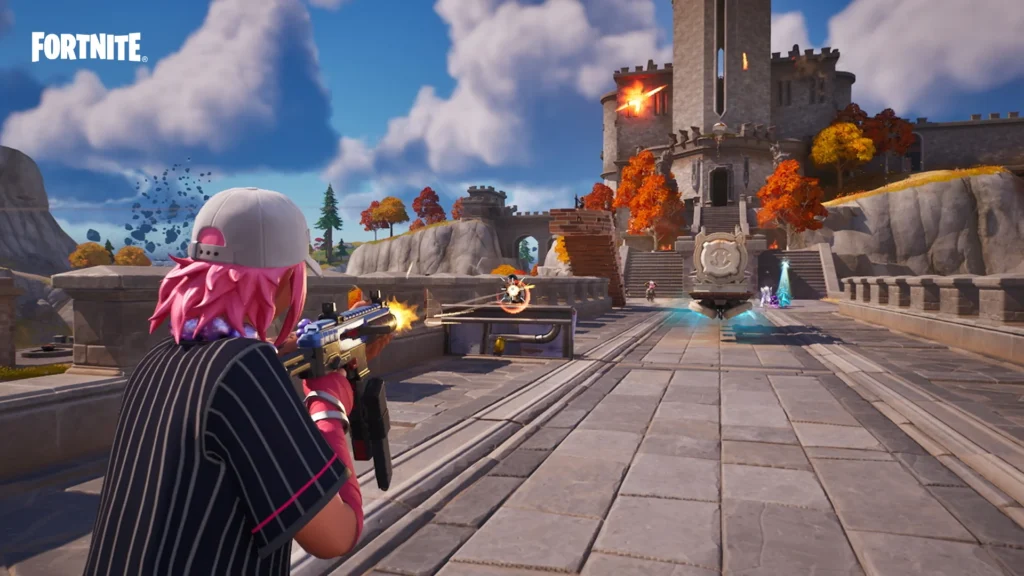Introduction to the Battle Royale Phenomenon
The battle royale genre has revolutionized the landscape of gaming, emerging as one of the most dominant formats in recent years. This genre, characterized by its free-for-all gameplay that often pits dozens or even hundreds of players against one another until only one remains, has captivated an expansive audience. The success of titles such as Fortnite, Apex Legends, and Call of Duty: Warzone is largely attributed to their innovative approach to gameplay mechanics and player engagement. Each game brings its own unique style, mechanics, and social interaction, helping to further amplify the appeal of the battle royale format.
Fortnite, perhaps the most iconic title in this genre, introduced building mechanics that allow players to construct fortifications rapidly, adding a layer of strategy that differentiates it from its competitors. Its vibrant graphics, frequent content updates, and seasonal events continuously engage players, fostering a dynamic community. Apex Legends, on the other hand, has redefined character-based gameplay with its unique legends, each possessing distinct abilities that promote teamwork and strategy, enhancing the battle royale experience. This innovative gameplay model has attracted a dedicated player base that appreciates strategic depth alongside fast-paced action.
Additionally, Call of Duty: Warzone has combined traditional first-person shooter elements with battle royale gameplay, delivering a familiar yet refreshing game mode for long-time fans of the series. Its integration of features like loadout drops and the Gulag system encourages tactical decision-making and enhances player engagement. Together, these titles have not only surged in popularity but have also reshaped the gaming industry’s approach to rewards. The emphasis on player engagement through skill progression, seasonal challenges, and in-game rewards has created a cycle of continual player investment, thereby solidifying the battle royale genre’s sustained prominence in the gaming community.
Unique Gameplay Elements in Fortnite
Fortnite has emerged as a leader within the battle royale genre, thanks to its distinctive combination of gameplay mechanics that sets it apart from its competitors. One of the most significant features is its building mechanics, which introduce a layer of strategy that is often absent in traditional shooters. Players can collect resources to construct structures—ranging from simple walls to complex fortifications—that influence their positioning and combat strategy. This incorporation of building not only adds an element of risk but also challenges players to think critically about their defensive and offensive maneuvers in a dynamic environment.

The vibrant graphics and visual style of Fortnite contribute significantly to its appeal. The bright, cartoon-like aesthetics attract a diverse demographic of players, from children to adults, who seek a more welcoming and engaging atmosphere. This visual charm, combined with a playful theme, emphasizes creativity and fun, inviting players to immerse themselves in the game without the darker undertones present in many other titles in the genre. Additionally, the game’s lively aesthetic enhances the experience by making the fast-paced action more digestible and the frantic moments memorable.

Furthermore, Fortnite’s commitment to regular seasonal content updates keeps the game fresh and captivating. Each season introduces new themes, gameplay mechanics, and limited-time events that motivate players to return. This rotational content fosters an ongoing sense of discovery and excitement, as players navigate through evolving landscapes and new challenges, thus enriching the overall gameplay experience. The strategic elements of risk in player decision-making become apparent; whether choosing to engage in battle or taking the time to gather resources, each moment in Fortnite beckons players to adapt their strategies for survival and victory.
Apex Legends: Innovation and Teamwork
Apex Legends has made a significant impact in the battle royale genre by introducing innovative gameplay mechanics that prioritize teamwork and collaboration among players. One of the game’s most notable features is its unique ping system, which allows players to communicate crucial information without the need for voice chat. This tool empowers even casual players to contribute effectively, marking a departure from traditional battle royale games where communication often relied heavily on voice interaction. The ping system enables players to mark locations, enemies, and items, fostering a strategic dialogue that enhances gameplay.

Moreover, Apex Legends stands out with its character-driven dynamics. Each Legend possesses distinct abilities that cater to diverse play styles, promoting not only individual skill but also collective strategy. The game’s roster encourages players to experiment with various combinations of Legends, allowing them to create synergies that are beneficial in combat scenarios. For instance, a squad composed of a support character and an offensive character can harness their unique skills to outmaneuver opponents, showcasing the importance of coordination in gameplay.
The emphasis on teamwork is further complemented by the game’s design, which encourages players to adopt roles that align with their chosen Legends. This structure cultivates an environment where communication is vital for success, making it imperative for players to share information and collaborate effectively. As such, Apex Legends does not simply reward individual prowess; rather, it underscores the necessity of cooperative strategies and mutual support among team members.

In a rapidly evolving genre, Apex Legends exemplifies how innovative gameplay mechanics and character diversity can significantly enhance the battle royale experience. By promoting strategic communication and teamwork, the game has successfully distinguished itself and continues to cultivate an engaging community of players committed to mastery and collaboration.
Call of Duty: Warzone – Realism and Competitive Edge
Call of Duty: Warzone has established itself as a formidable player in the battle royale genre, setting itself apart through its commitment to realism and competitive gameplay. Developed by Infinity Ward and published by Activision, this game not only offers high-fidelity graphics but also enables a deeply immersive experience that resonates particularly well with seasoned gamers.
The graphical fidelity of Warzone is among the highest in the industry, featuring detailed environments, lifelike character models, and dynamic weather effects that enhance the overall gameplay experience. Each map is meticulously designed to reflect various real-world landscapes, which creates a sense of authenticity that is appealing to players seeking more than just a casual gaming experience. This attention to detail plays a crucial role in maintaining the interest of competitive players who value immersion and realism in a battle royale setting.

Furthermore, the fluid mechanics of Warzone contribute significantly to its competitive edge. The game boasts responsive controls and a robust movement system that allows players to execute movements seamlessly, including sliding, climbing, and tactical sprinting. These elements promote a skill-based environment where players must master their mechanics to gain an advantage over opponents. The incorporation of tactical elements, such as loadouts and the Gulag system, where players have a second chance to re-enter the battlefield, adds layers of strategy and excitement to each match

Additionally, the integration of the Call of Duty franchise enhances the appeal of Warzone. Fans of the series appreciate familiar weapons, modes, and gameplay styles, while newcomers are drawn in by the game’s competitive nature. The balance of luck and skill required for success in Warzone keeps players engaged and striving for improvement. As a result, Call of Duty: Warzone not only satisfies a desire for action and excitement but also cultivates a community that thrives on competition and performance. Through its realism and state-of-the-art gameplay mechanics, Warzone continues to solidify its status at the forefront of the battle royale genre.
Social Interaction and Community Building
The battle royale genre has garnered immense popularity, and titles like Fortnite, Apex Legends, and Call of Duty: Warzone have become cornerstones in this realm, largely due to their emphasis on social interaction and community building. Players are not merely participants in a game; they are encouraged to engage with one another, fostering a sense of camaraderie and shared experience that enhances the overall gaming environment.
One significant aspect contributing to this phenomenon is the formation of squads. In these games, players often team up with friends or make new connections while tackling challenges together. The cooperative gameplay mechanics necessitate communication and collaboration, which naturally cultivates friendships. This social dynamic is further emphasized in games like Apex Legends, where each character has unique abilities that complement team strategies, promoting teamwork as players must rely on one another to achieve victory.
Moreover, streaming on platforms such as Twitch and YouTube has propelled these titles into the spotlight, allowing gamers to share their experiences while attracting new players. Content creators often host live sessions where viewers engage in real-time discussions, creating a vibrant community atmosphere. These platforms serve as additional social hubs, allowing fans to interact not only with streamers but also with each other, sharing tips, strategies, and memorable moments from gameplay.
Participation in community events also plays a critical role in building connections among players. Seasonal events, challenges, and competitive tournaments hosted by the developers help foster a shared purpose, bringing gamers together and encouraging them to celebrate their achievements collectively. The anticipation surrounding these events often translates into increased player engagement, as veteran and new players alike are drawn back to the game, eager to partake in these community-centered experiences.
Mobile Play and Accessibility
As mobile gaming continues to grow in popularity, its impact on the battle royale genre has become increasingly significant. Titles like Fortnite and Call of Duty: Warzone have skillfully adapted their gameplay mechanics to suit mobile platforms, thereby expanding their reach and accessibility to a wider audience. This shift reflects an understanding of current gaming trends, where players prefer the flexibility of engaging in gaming sessions on their mobile devices, often while on-the-go.
The mobile versions of these popular battle royale games maintain core gameplay features, enabling players to enjoy the same competitive experience as their console and PC counterparts. For instance, Fortnite’s mobile adaptation includes touch controls that are intuitive and responsive, while offering a similar user interface that retains the essence of the game. Meanwhile, Call of Duty: Warzone on mobile provides an optimized experience, with customizations to controls and graphics that enhance playability without compromising performance. This attention to detail ensures that mobile players can engage fully with the game.
Furthermore, the rise in mobile gaming leads to increased player engagement, attracting diverse demographics who may not own traditional gaming consoles. This inclusivity not only bolsters player communities, making them more vibrant and dynamic but also increases potential payouts through gaming rewards. The accessibility of mobile platforms allows for larger tournament participation, where players have the opportunity to win in-game currency, skins, or even cash prizes. Thus, the integration of mobile capability within battle royale games serves as a bridge to reach untapped markets and reinforces the importance of adaptability in a competitive landscape.
The Role of Seasonal Content and Updates
In the competitive landscape of battle royale games, the implementation of seasonal content and regular updates plays a crucial role in maintaining player engagement and enhancing the overall gaming experience. Titles such as Fortnite, Apex Legends, and Call of Duty: Warzone demonstrate how strategic updates can keep their player base consistently invested. These games do not rely solely on their core mechanics; they actively integrate new content to stimulate interest and foster a dynamic environment.
Each season introduces a plethora of updates that can include new maps, skins, weapons, and gameplay mechanics. For instance, Fortnite’s seasonal chapters are renowned for their thematic shifts and innovative tie-ins with popular culture, such as collaborations with movies and music. This strategy draws players back into the game with the promise of unique experiences and limited-time events, which often feature exclusive rewards that cannot be obtained at any other time. Such time-sensitive offers contribute to a sense of urgency and provoke players to participate actively in the evolving narrative.
Similarly, Apex Legends employs their seasonal updates to introduce new legends, balanced gameplay changes, and additional story elements through its lore-driven approaches. This ensures that both new and existing players find something that captures their interest, thus promoting a diverse player experience. Moreover, Call of Duty: Warzone frequently rolls out challenges and seasonal rewards that compel players to engage in the game on a continual basis, enhancing the thrill and providing fresh objectives.
Overall, the developers of these battle royale games recognize that seasonal content and updates are not merely enhancements; they are fundamental to keeping the gameplay experience vibrant and engaging. By consistently surprising players with new elements and maintaining a steady stream of updates, these games manage to secure their dominance in the ever-evolving battle royale genre.
The Influence of Streaming and eSports
In recent years, streaming platforms such as Twitch and YouTube have played a pivotal role in shaping the landscape of competitive gaming, particularly within the battle royale genre. Games like Fortnite, Apex Legends, and Call of Duty: Warzone have seen significant success, largely due to the visibility and accessibility provided by these platforms. The ability to watch skilled players tackle challenges and master game mechanics captivates audiences, fostering a keen interest in not only the games themselves but also in the broader eSports ecosystem. This phenomenon has markedly elevated the profile of battle royale games.
The allure of eSports tournaments further contributes to this trend. Events such as the Fortnite World Cup and various Call of Duty League competitions draw massive viewership, celebrating top-tier skills and strategies. Fans often tune in to witness some of their favorite players going head-to-head in high-stakes environments, where teamwork, strategy, and quick reflexes define the outcome. The excitement of watching these competitions adds to the narrative of the games, embedding them deeper into popular culture. This thrill translates into increased engagement and participation at the casual level, as new players aspire to replicate the feats of their idols.
Moreover, the gaming community thrives on the viewing experiences offered through streaming. Commentators and streamers facilitate connections among fans, engaging with them in real-time via chat interactions and social media. This sense of belonging encourages casual players to explore the nuances of gameplay, ultimately enhancing their strategies within the game. The resulting synergy between viewing and playing creates an intricate feedback loop, promoting interest and investment in these titles. Thus, the convergence of streaming culture and eSports is a crucial factor in the enduring popularity of battle royale games.
Concluding Thoughts on Battle Royale Dominance
In recent years, the battle royale genre has seen a meteoric rise in popularity, with titles such as Fortnite, Apex Legends, and Call of Duty: Warzone leading the way. Each game has carved out a distinct niche, contributing to their overall dominance in the gaming landscape. Their success can largely be attributed to several key elements that appeal to a wide array of players.
First and foremost, gameplay mechanics play a critical role. Fortnite’s building system introduces a unique strategic layer, while Apex Legends offers character-based abilities that redefine player roles in matches. Call of Duty: Warzone, on the other hand, leverages its established franchise reputation and familiar mechanics, attracting both veteran players and newcomers alike. The balance between innovation and familiarity in these games fosters an engaging experience that keeps players coming back.
The community surrounding each title also significantly impacts their success. These games have cultivated inclusive environments where players connect through live events, social media, and competitive tournaments. This community engagement promotes a sense of belonging and loyalty, which in turn influences player retention rates and encourages further growth. Moreover, regular updates and seasonal content ensure that the gaming experience remains fresh and exciting, adapting to player feedback and emerging trends.
Finally, the shifting dynamics of gaming culture have positioned these games at the forefront of an evolving entertainment medium. The rise of streaming platforms and the integration of visual storytelling have transformed how players interact with games, raising expectations for immersive experiences. As the battle royale genre continues to evolve, Fortnite, Apex Legends, and Call of Duty: Warzone exemplify the potential for synergy between gameplay innovation, community interaction, and cultural relevance. These elements not only solidify their status within the genre but also pave the way for future developments in gaming.

